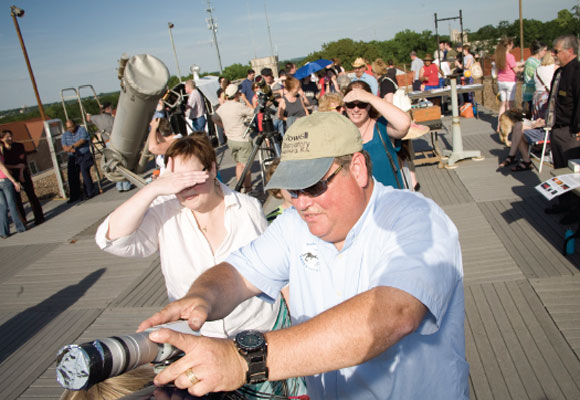Hallie Spencer // Spring 2015

Driven by a desire to view the cosmos and a love for his wife, Stan Warkoczewski spent nearly 10 years and $15,000 building the 16-inch diameter reflecting telescope that today sits atop Royall Hall on UMKC’s campus. A true labor of love: the telescope was a gift for his wife, Helen, who introduced him to astronomy.
 After the telescope was completed in 1958, the Warkoczewskis, who lived close to UMKC’s campus, often invited students to their backyard to use the telescope. Stan even joined other amateur astronomers in scouring the moon for potential landing sites for the Apollo missions. In 1964, the Warkoczewskis donated the telescope to the university, but it was 10 years before it became a permanent fixture on Royall Hall.
After the telescope was completed in 1958, the Warkoczewskis, who lived close to UMKC’s campus, often invited students to their backyard to use the telescope. Stan even joined other amateur astronomers in scouring the moon for potential landing sites for the Apollo missions. In 1964, the Warkoczewskis donated the telescope to the university, but it was 10 years before it became a permanent fixture on Royall Hall.
“The ‘Warko’ Observatory is one of the many treasures on campus,” says Arts and Sciences Associate Dean Kati Toivanen.
This past year the Warkoczewski Observatory, one of only two major observatories open to the public in the region, celebrated its 40th anniversary on Royall Hall.
The observatory is free and open to the public. Every Friday night, May 1 through Oct. 31, students and families in the community join members of the Astronomical Society of Kansas City (ASKC) on the roof of Royall Hall to view the heavens.
Observation usually begins at dusk and ends around 10 or 11 p.m. but if you arrive an hour before sunset, you’ll have an opportunity to view the sun through special filters allowing views of sunspots and, if you’re lucky, flares on the surface of the sun.

“Visiting the observatory is a great activity for families,” says Daniel McIntosh, Ph.D., associate professor of physics and astronomy and director of the Warkoczewski Observatory. “It’s fun and free. The staff are knowledgeable and are always introducing new things to see throughout the night.”
Though surrounded by city lights, the telescopes are powerful enough to view details on most of the Solar System’s planets.
“You can see the big red spot on Jupiter and often see its four largest moons in orbit,” McIntosh says. “If you look at our moon, which is much closer, it’s so large and detailed you feel like you’re about to fly over one of its mountain ranges and land in a crater.”
In addition to the Warkoczewskis’ telescope, the observatory houses a computer-controlled, 14-inch diameter Meade telescope that was a combined gift from the College of Arts and Sciences alumni and members of the ASKC. It is able to locate fainter objects such as star clusters and different types of nebulae, which provide glimpses of the different stages of stellar lives.
“When I was a teenager, the Voyageur missions were flying by Jupiter and Saturn. As a kid the illustrations of the planets were hand drawn, but now, all of sudden, we had photos,” McIntosh says of the beginning of his love for astronomy. “Even the moons of these giant planets looked like little worlds. That really opened up everything for me.”
Today, science books are filled with images captured by the Hubble Space Telescope cameras.
 “Our eyes can’t record light like cameras can,” McIntosh says. “To get a good photo of a planet, you have to have a really long camera exposure and our eyes just can’t stay open that long or process light in that way.”
“Our eyes can’t record light like cameras can,” McIntosh says. “To get a good photo of a planet, you have to have a really long camera exposure and our eyes just can’t stay open that long or process light in that way.”
While the views through the telescopes at the observatory won’t match the detail of the images you see taken by the Hubble Space Telescope, the opportunity to see a planet with your own eyes through a telescope is a thrilling experience for many.
“I’ve never seen a kid look through a telescope and not say ‘Wow!’” McIntosh says. “Everyone remembers the first time they see the rings of Saturn and realize they’re real.”
Visit the “Warko”
Every Friday night (weather permitting)
May 1- Oct. 31
Viewing hours: One hour before sunset until 10-11 p.m.
Free admission
cas.umkc.edu/physics/warko/
Twitter updates on viewing: twitter.com/WarkoSky
Learn More About Astronomy
Astronomical Society of Kansas City
askc.org
Meetings every 4th Saturday
7 p.m. at UMKC Royall Hall Room 111
6 p.m. Astronomy 101 series
Of Interest: meteor collections, astrophotography, workshops, telescopes available to borrow
